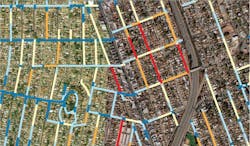About the author: Lars Stenstedt is co-founder and chief operating officer of Fracta. Stenstedt can be reached at [email protected] or 510.299.2151.
There is a $1 trillion challenge facing water utilities as they work to prioritize main replacements. Replacement decisions currently are based on incomplete physical or desktop assessment methods, resulting in an inefficient process that risks prioritizing the replacement of healthy pipes over unhealthy pipes, wasting utility dollars. Of the 50,000 U.S. utilities, only the most sophisticated are fully aware of the issue, and far fewer are capable of mitigating the problem, given the current lack of accurate, complete assessment tools and technology.
As breaks and leaks increase, the budgets for condition assessment and replacement remain limited, leaving utilities with a burgeoning obstacle. The available assessment options do not provide a scalable solution. Physical condition assessment is risky and expensive, while desktop condition assessment, based on age, leak history and causation theories with a limited number of variables, lacks accuracy and cannot predict leaks on “virgin” pipes.
The solution to this growing problem is machine learning. Machine learning is a field of artificial intelligence (AI) that focuses on allowing computers to learn from information and analyze large amounts of data to find patterns and hidden insights. AI and machine learning are expected to fuel the next industrial revolution, just as mobile did a decade ago.
Growing Investment
According to McKinsey Global Institute’s June 2017 discussion paper, companies invested between $26 billion and $39 billion in AI in 2016. Machine learning is the only way to mathematically optimize a large set of variables, whether it is identifying visual patterns using computer vision for image recognition, working to understand speech or identifying pipes that are likely to fail.
Machine learning builds a model using training and validation data to predict future data. The training data is used to iteratively build a model around how different variables correlate with a target value, and the model is tested with known validation data to see how well it can forecast the target value. The model then is applied to predict future data based on the algorithm developed with the training and validation data it gathered as it learned.
Applied to water, machine learning can assess and assign every pipe segment in a system a reliable Likelihood of Failure (LOF) probability score. Compared to the currently available assessment methods, machine learning provides a more accurate LOF rating in a matter of months, and at a fraction of the cost typically needed for such assessment.
Phases of Deployment
There are three steps to deploy a big data machine learning solution: data collection and assessment, machine learning analysis and action plan creation from LOF results.
Phase 1: Data collection & assessment. The first step is to aggregate, clean up, and normalize data about utility pipe parameters (location, length, material, diameter, install year, etc.) and history, providing a visual representation of the current asset state. Collect information about geographic features (soil quality, weather patterns, etc.), transportation, population density, etc. and provide it to the learning engine.
Phase 2: Machine learning analysis. The machine learning engine develops its algorithm using the known training and validation data from phase one, then outputs predicted LOF rankings for all the utility’s pipes. Machine learning is the only way to quickly and effectively analyze hundreds of variables that have an impact on a pipe’s likelihood of failure.
Phase 3: Action plan creation from LOF results. After viewing or downloading the results, utilities can review and modify existing replacement plans to focus replacement on the highest risk segments to optimize replacement spending. The rankings can be used to identify the worst contiguous pipe segments and adjust replacement budgets as necessary. By focusing on the pipes that need more immediate replacement, machine learning can save the water utility millions of dollars in replacing healthy pipe.
Fracta Inc. has successfully used this machine learning-based approach with multiple large utilities since 2016. The productized, scalable, machine learning product can deliver the benefits of this approach to small and large water utilities in a fraction of the time and cost typically used for such analysis.
The accuracy of a machine-learning algorithm increases over time as more utility data is added and rankings are validated in the field. From a long-term perspective, these algorithms also will be leveraged to cover gaps in data at smaller, localized utilities.
Machine learning is a scalable solution for utilities looking to accurately assess pipe replacement needs, forecast risk and control spending. With the comprehensive view of conditions, machine learning will allow utilities to optimize replacement decisions and defer unnecessary replacements to reduce water main replacement liability by 40% or more between now and 2050.
